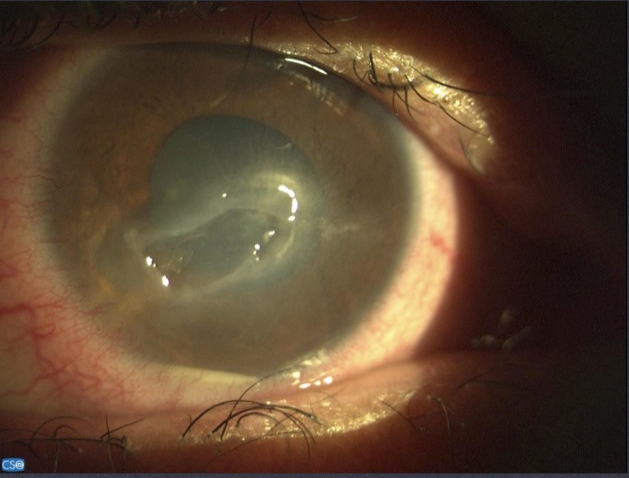Neurotrophic keratitis (NK) is a rare, degenerative corneal disease caused by damage to the trigeminal nerve (cranial nerve V), leading to a loss of corneal sensation. This impairment affects tear production, epithelial integrity, and wound healing, often resulting in corneal ulceration, scarring, and vision loss.
Despite being uncommon, NK is a progressive and potentially sight-threatening condition. Early diagnosis and intervention are critical to prevent complications and preserve vision.

Pathophysiology of Neurotrophic Keratitis
Neurotrophic keratitis results from impaired corneal innervation, disrupting the corneal healing process and leading to chronic epithelial breakdown. The loss of sensory feedback reduces reflex tearing, decreases blink frequency, and weakens corneal repair mechanisms.
Causes of Neurotrophic Keratitis
Several conditions can impair the trigeminal nerve, leading to neurotrophic keratitis.
1. Ocular and Neurological Disorders
- Herpes simplex keratitis and herpes zoster ophthalmicus – Viral infections that cause nerve inflammation and corneal damage.
- Corneal surgery or trauma – Procedures like LASIK, corneal transplants, or cataract surgery can damage corneal nerves.
- Trigeminal neuralgia and neurosurgical procedures – Compression, injury, or surgical interventions affecting the trigeminal nerve.
2. Systemic Diseases
- Diabetes mellitus – Chronic hyperglycemia can impair corneal nerve function and reduce sensation.
- Multiple sclerosis (MS) – Demyelination of the optic and trigeminal nerves affecting corneal health.
- Leprosy – A bacterial infection that leads to nerve degeneration and corneal hypoesthesia.
3. Congenital and Genetic Disorders
- Congenital corneal anesthesia – Rare genetic disorders affecting sensory nerve development.
- Familial dysautonomia – A genetic condition that impairs autonomic and sensory nerve function.
Symptoms of Neurotrophic Keratitis
The hallmark of NK is a reduction or complete loss of corneal sensation, leading to a lack of pain perception. Since patients often do not feel discomfort, the disease can progress unnoticed until advanced stages.
Early-Stage Symptoms (Mild NK, Stage I)
- Dryness, redness, and blurred vision.
- Recurrent epithelial erosions due to impaired healing.
Moderate-Stage Symptoms (Stage II)
- Persistent corneal defects and punctate epithelial keratopathy.
- Increased risk of corneal infections and inflammation.
Advanced-Stage Symptoms (Severe NK, Stage III)
- Corneal ulceration and stromal melting.
- Corneal scarring and vision loss.
- Possible corneal perforation requiring surgical intervention.
Diagnosis of Neurotrophic Keratitis
1. Clinical Examination
- Corneal sensitivity test – Using a cotton wisp, esthesiometer, or Cochet-Bonnet esthesiometer to assess corneal sensation.
- Slit-lamp biomicroscopy – Evaluates corneal integrity, tear film stability, and presence of epithelial defects.
2. Specialized Tests
- Fluorescein staining – Identifies areas of corneal damage and epithelial defects.
- Schirmer’s test – Assesses tear production.
- OCT (Optical Coherence Tomography) – High-resolution imaging to evaluate corneal thickness and ulcer depth.
3. Neurological Assessment
- Evaluation for trigeminal nerve dysfunction, including history of herpes infections, trauma, or systemic diseases affecting the nervous system.
Treatment of Neurotrophic Keratitis
The primary goal of treatment is to promote corneal healing, prevent complications, and restore ocular surface integrity.
1. Medical Management (Non-Surgical Treatments)
Tear Film and Ocular Surface Protection
- Preservative-free artificial tears – Maintain corneal hydration and lubrication.
- Autologous serum eye drops – Rich in growth factors and cytokines, these promote epithelial regeneration.
Growth Factor Therapy
- Recombinant human nerve growth factor (rhNGF, Cenegermin) – Stimulates corneal nerve regeneration and epithelial healing.
Anti-Inflammatory and Antibiotic Therapy
- Topical corticosteroids (low-dose) – Reduce inflammation while minimizing epithelial toxicity.
- Prophylactic antibiotics – Prevent secondary bacterial infections.
2. Surgical Interventions
For moderate to severe NK, surgical approaches may be necessary.
Tarsorrhaphy (Eyelid Closure Surgery)
- Partially or fully closes the eyelids to reduce corneal exposure and enhance healing.
Amniotic Membrane Transplantation (AMT)
- Biological tissue grafts with anti-inflammatory and regenerative properties.
Corneal Neurotization Surgery
- Restores corneal innervation by transferring a healthy nerve graft from an adjacent facial nerve.
Keratoplasty (Corneal Transplantation)
- Reserved for advanced corneal scarring or perforation.
Prognosis and Complications
Early detection and intervention significantly improve visual outcomes. However, untreated neurotrophic keratitis can lead to:
✅ Permanent corneal opacification.
✅ Progressive vision loss and blindness.
✅ Corneal perforation requiring emergency grafting.
Prevention of Neurotrophic Keratitis
1. Regular Eye Examinations
- Patients with diabetes, herpes infections, or neurological disorders should undergo routine corneal sensitivity assessments.
2. Protection Against Ocular Trauma
- Use protective eyewear to prevent corneal injuries.
3. Early Management of Systemic Diseases
- Strict glucose control in diabetes.
- Prompt antiviral treatment for herpes keratitis.
Neurotrophic keratitis is a progressive degenerative eye disease that requires early diagnosis and prompt treatment to prevent severe vision impairment. Advances in growth factor therapy, corneal neurotization, and regenerative medicine offer promising solutions for restoring corneal health. Regular eye screenings and proactive management are essential in reducing the risk of complications.